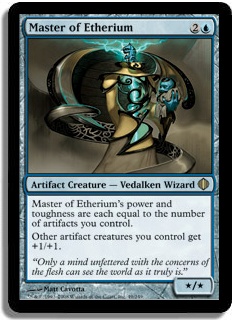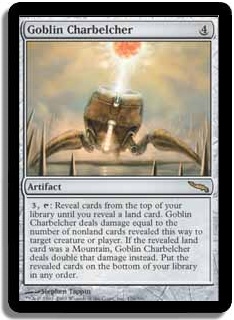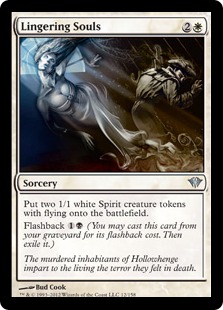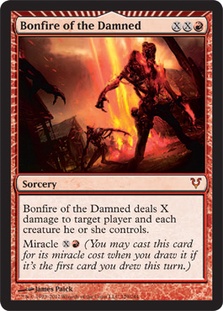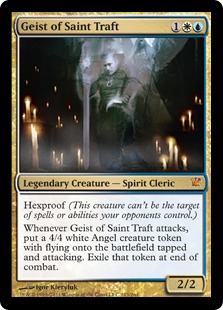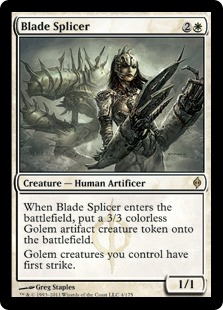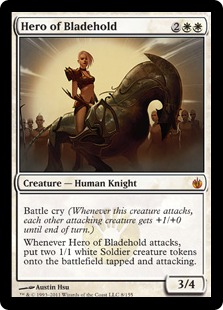Like southpaws favoring their left hands, many players return to deck archetypes time and again. Cedric Phillips and his Kithkin and Patrick Sullivan and his Arabian Nights Mountains have found some measure of fame and fortune with their signature deck styles. My career has been far more obscure, but the pattern still holds. If you sit across from me at a Magic tournament, there are two easy assumptions you can make: first, I’ll be playing an aggro or combo deck, whatever the format; second, if the card pool is Modern or larger, I’ll be playing with artifacts.
See? I’m flexible.
This past year in Standard, white-based Token Aggro has been my go-to archetype. Sure, I’ve dabbled with Wolf Run Ramp on occasion and Ryan Hipp’s Mono-Red Stuffy Doll (suggested new name: "Dollhouse") is a fascinating deck I’d love to build, but when I’ve done well this season, it’s been with Lingering Souls in my graveyard and Intangible Virtue on the board. Of course, Grand Prix Salt Lake City coincided with the quaint, quaint time when Bonfire of the Damned was a Wizards of the Coast secret, not a $50 rectangle of cardboard. Then again, life’s too short to be standing outside the fire. Why not take a risk or two, especially when it can be managed?
After I gave up on Wolf Run Ramp, I went back to Tokens, searching for a way to make it relevant again in the Age of Bonfire. I liked the recent Magic Online list but still wasn’t satisfied with cards such as Mirran Crusader in the three-slot. Strangely enough, my answer to the "Bonfire problem" was one of the same cards Bonfire of the Damned was meant to answer: Geist of Saint Traft.
Cause and effect, chain of events, all of the chaos makes perfect sense…
With decks and threats as diverse as they are in the current metagame (and make no mistake, this is a far more diverse metagame than many feared it would be), I decided to shunt all my removal to the sideboard and "loaded the box" with threats for my game 1s. With apologies to The Sound of Music and its origin in the memoir of Maria von Trapp, here’s the deck I registered for a $5,000 tournament the weekend before last in Fort Worth:
Creatures (20)
Lands (24)
Spells (16)

Let’s get one thing out of the way first: yes, Bonfire of the Damned is still a miserable, miserable time for this deck. The trick is to manage the board and avoid getting blown out too badly. Most of the time, I aim to avoid the "two-for-one," but a "one-and-a-half-for-one" (a card and half a Lingering Souls or a Champion of the Parish and a Doomed Traveler that will make a Spirit token, for example) is fine in my book.
Other observations: for the amount of thought required to make the maindeck with its Geist of Saint Traft and the mana base to support it work, the sideboard really is half-baked. (Not one blue card at all?) In the maindeck, meanwhile, the Moorland Haunt should’ve been a second Vault of the Archangel. The solitary Moorland Haunt did not live up to my ideals for it as a board-wipe recovery mechanism, but whenever my one copy of Vault of the Archangel landed on the battlefield, the whole tenor of the match changed.
On to the tournament!
The Tournament
In lieu of the usual blow-by-blow style (cast spells, turn creatures sideways, and so on), I’ll highlight the primary and secondary considerations that swung the match one way or the other.
Round 1 vs. Neil Curran (RUG Delver)
Primary Factor: Mulligans and Mana Flood
This match had me questioning my shuffling technique, my mana mix…everything. First game: I mulliganed to five and won. Other two: I mulliganed to six and lost. Going from a first game of "beat the mulligan to five!" to a third game of "land, land, land, land, I lose" wasn’t pleasant, but I didn’t have more than three mulligans in the rest of the tournament, so I’m chalking this one up to a mix of poor decisions on my part compounded by luck.
Secondary Factor: Bonfire of the Damned
With Bonfire of the Damned in play for this match, seemingly "board stable" states could turn messy in the flip of a card. In the second game, I beat back a quick Delver of Secrets and Quirion Dryad blitz but slipped to two life. While I had the battlefield, I knew I was racing to either kill the opponent or draw Vault of the Archangel before he came up with the necessary burn spell to off me. A Pillar of Flame would have done the job just as well, but he miracle cast a Bonfire of the Damned instead, immolating me with $50 in cardboard. It wasn’t quite the "golden crown" Khal Drogo dumped on Viserys Targaryen’s head in A Game of Thrones, but it was close.
Loss 1-2
Round 2 vs. Richard Beard (Mono-Green Infect)
Primary Factor: Lingering Souls
Mike Byrne survey of the last month of Magic 2013 Standard from Monday has it right: while Infect decks can pack a lot of power, they hate Lingering Souls to Kefka-esque proportions. Tokens von Traft is the "control" in this matchup, and the mission is simple: throw bodies in front of bodies until you have the last bodies left standing. Come to think of it, that’s perfect for an omnicidal creeper like Kefka…
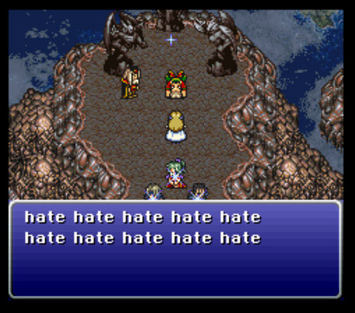
Secondary Factor: Matchup Familiarity
I’d dealt with Mono-Black Infect back in the Dark Ascension days. While Mono-Green Infect isn’t the same deck, it does have enough similarities that I was comfortable with the tenets of the match, more so than my opponent. He gave it a good go and knocked me out of a game where I didn’t have the flying creatures to contain his Inkmoth Nexus, but I won in the end.
Win 2-1
Round 3 vs. Thomas Leavy (U/W/R Midrange, Calcano-Style)
Primary Factor: Hero of Bladehold
Big enough to take down a Blade Splicer’s Golem token and bounce off a Restoration Angel without any backup, the Hero of Bladehold and her one-woman army starred in this matchup. After the midrange deck had to clear away my early offense, my own midrange beats came down, and eventually the other deck ran out of options. Then I won.
Secondary Factor: Bonfire of the Damned
My opponent was banking on Bonfire to close me out, but it didn’t turn out that way. In the second game, I was Bonfired twice, first for one damage to clear out some tokens and another time for three damage, but they didn’t keep his life total from draining to nothingness. Similarly, Gideon Jura ended up being nothing more than a five-mana Fog. Gideon Jura has been known to hold a grudge, as I was soon to find out…
Win 2-0
Round 4 vs. Juan Loya (U/W Splicer Delver)
Primary Factor: Time Maintenance
Simply put, I failed to monitor the clock and did not know when to give up on a game that I would inevitably lose. I won the first game in decent time, but the second dragged on thanks to the influence of Rhox Faithmender. After fifteen life changes on my opponent’s part and ten on mine, he managed to deal the killing blow in extra turns, sealing a draw.
Secondary Factor: Blade Splicer
Who had the Splice Girl determined who took the match. Geist of Saint Traft came out because he doesn’t do enough against 3/3 first strikers, even with an Honor of the Pure on the board. When he’s good he’s good, but I know when to give him the hook.
Draw 1-1
Round 5 vs. John Cerreta (G/R Midrange)
Primary Factor: Vault of the Archangel
I ended the first game at 43 life and the second at 39. It didn’t matter if Wolfir Silverheart was soulbonding with Huntmaster of the Fells like Rose and Jack in Titanic; when the Vault came down, I went iceberg on that romance.

Secondary Factor: Hero of Bladehold
How did I get my life total so high? Hero of Bladehold and the Soldier tokens. Was it completely unfair to get my one Vault of the Archangel and wind up holding out for a Hero every game? Sure, but that’s Magic.
Win 2-0
Round 6 vs. Nicholas Scott (U/W Geist Delver)
Primary Factor: The Gitaxian Probe of Doom
After making a fool of myself by writing his name down as "Scott Nicholas" (I know you get it a lot, but I’m still sorry!), I then had my most unfair game of the tournament. After I befuddled him with Darkslick Shores into Plains into Gather the Townsfolk and his third-turn Geist of Saint Traft met mine, he used Gitaxian Probe on me. I flashed him this. It was all over but the shouting.
Secondary Factor: His Mulligan to Four in the Second Game
Make no mistake, though; he made a game of it with a quality four-card hand and strong draws. But once I found Vault of the Archangel, my life total went out of reach and his slipped away.
Win 2-0
Round 7 vs. James Wise (Esper Control)
Primary Factor: The James Wise Effect
Perhaps you have a Magic frenemy or flat-out nemesis. James Wise falls into the former category for me. He’s an older gentleman with a long history in the Texas Magic community, several Pro Tours under his belt, and a piece of dirt on me from my more reckless younger days when I thought that getting dessert after a meal at Fogo de Chao was a good idea. (For the record: don’t.) In any event, Mr. Wise has my number, and I was already in a rough frame of mind when he sat down across from me with his wicked infectious grin; just knowing he was my opponent was enough. I’ll break the James Wise Effect one day, but August 25 wasn’t it.
Secondary Factor: Matchups Matter (Part Deux)
The first game involved a combination of Day of Judgment and Terminus alongside one-for-ones, always knocking out my creatures just in time, until a miracle Entreat the Angels gave me one turn to find a solution. I didn’t. The second was full of seesaw drama: Day of Judgment, miracle Terminus, Day of Judgment, hard cast Terminus, Snapcaster Mage targeting Day of Judgment, and a standoff between four Entreat the Angels tokens and four Lingering Souls tokens powered up by a pair of Honor of the Pure and an Intangible Virtue that ended in mutually assured token destruction. Then Gideon Jura came down, though, followed by Tamiyo, the Moon Sage. Pretty soon my creatures were getting locked down and I was getting whipped to death six points of Gideon Jura damage at a time.
Loss 0-2
Round 8 vs. Nick Seger (Naya Pod)
Primary Factor: Vault of the Archangel (as a no-show)
In the first and third games I got Nick down to four life, but I ran out of time before I could close the deal. Had I had Vault of the Archangel instead of Moorland Haunt, either of those losses would have turned to a win.
Secondary Factor: Thundermaw Hellkite
The Hellkite did a number on me in the first game…twice. It never killed my Lingering Souls tokens, but it did a number tapping them down, blasting me when it came in off a Birthing Pod and again with a Restoration Angel Blink. The second time, I was on four life. Frowns.
Loss 1-2
Round 9 vs. Rhendelle Rhodes (Mono-White Trading Post)
Primary Factor: Trading Post
Mono-White may not be a common color for Trading Post, but Mr. Rhodes did a number on me when I stalled out, gaining four life and discarding cards until he found Day of Judgment to clear my creatures away. Looking at the life totals from my records, Mr. Rhodes was at one life twice, three life twice, and five life twice. Vexatious!
Secondary Factor: Lingering Souls
As always with board-sweeping matches, the Lingering Souls were my go-to recovery mechanism. Even in the second game, which I lost, they dominated the tempo as I pulled him down to two life… Right before Elesh Norn, Grand Cenobite made me cry.
Win 2-1
Where Will Tokens Go After Return to Ravnica?
The white-heavy Tokens archetype is going to take certain losses with the rotation, but they’re not unrecoverable. Blade Splicer is out, as is Hero of Bladehold. Among noncreatures, Honor of the Pure is the big loss, but the future iterations of Tokens might not be so heavily oriented around white. There are possibilities involving W/B, of course, but also W/G (Selesnya Charm, Thragtusk, and other possible Selesnya goodies); W/R (Krenko’s Command, Hellrider); and even W/U (Geist of Saint Traft isn’t going anywhere).
Based on the early spoilers, I’m focusing on Junk (W/G/B) Tokens in the post-rotation environment until clues from the rest of Return to Ravnica tell me otherwise. In any case, I’m excited to see where Tokens might lead—secondarily, of course, to all the glorious Vorthos entertainment that Return to Ravnica promises.
As always, thanks for reading.
— JDB
@jdbeety on Twitter

